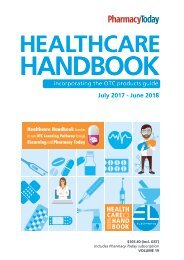2017 HCHB_digital
Create successful ePaper yourself
Turn your PDF publications into a flip-book with our unique Google optimized e-Paper software.
CONTINUING OTC EDUCATION<br />
brown and have a cauliflower-like appearance. Small black dots may be visible<br />
near the middle of the wart which is caused by bleeding. Verrucae are caused<br />
by the human papilloma virus which is contagious via wet floors. Although they<br />
can disappear spontaneously, this may take up to two years. Some people may<br />
require surgery to remove painful veruccae.<br />
Corns and calluses<br />
Corns and calluses are areas of hard, thickened skin which build up on areas of<br />
the feet subject to pressure and rubbing. Corns are smaller than calluses and<br />
develop on non-weight bearing parts of the foot, such as the tops of the toes.<br />
They have a hard centre and can be very painful. Calluses are flatter than corns<br />
and are often found on the heel or ball of the foot. Protect corns and calluses<br />
with moleskin or thin podiatry felt and advise customers to wear well-fitting<br />
shoes to reduce pressure and rubbing. A podiatrist may need to cut away the<br />
corn or callus to permanently remove it.<br />
Cracked heels<br />
Cracked heels are common in summer when people wear sandals or go barefoot<br />
and the feet dry out. Treat with a thick, oil-based moisturiser, applied twice daily,<br />
after using a pumice stone or foot file to remove any thickened skin.<br />
Blisters<br />
Blisters can form on the feet when the skin has been damaged (either by friction,<br />
rubbing or poor-fitting shoes), see Cuts, Abrasions and Blisters. Fluid collects<br />
between the upper skin layers and forms a small bubble or pocket. Most blisters will<br />
heal by themselves within three to seven days. Hydrocolloid dressings can be used to<br />
heal blisters, relieve pain and protect the area from further damage.<br />
Initial assessment<br />
If necessary, offer to take the customer into a private area where they can sit down and<br />
you can have a proper look at their feet. Wear gloves and examine the affected area,<br />
noting what symptoms correspond to the conditions above. Refer any customers with<br />
"yes" answers to the Refer to Pharmacist questions to a pharmacist. Also refer<br />
if you are unsure what the condition is, or do not know the appropriate treatment.<br />
Advice for customers<br />
Refer to<br />
PHARMACIST<br />
The following questions aim to identify customers who would<br />
benefit from further input from a pharmacist. Your initial assessment<br />
or a caregiver's history may have already provided some answers.<br />
Decide if any further questions still need to be asked and refer any<br />
“yes” answers to a pharmacist.<br />
• Does the person have any other health conditions (eg,<br />
immunosuppression, diabetes, is pregnant or breastfeeding)?<br />
• Is there any bleeding with the problem?<br />
• Has the condition persisted or recurred despite treatment?<br />
• Is a large area involved or are several nails infected?<br />
• Is the condition affecting other parts of the body (eg, face, scalp)?<br />
• Is the condition affecting the person’s ability to walk?<br />
• Is the corn soft and present between the person’s toes?<br />
• Are there any other symptoms (such as itching or a colour change<br />
in a suspected wart)?<br />
• Is the person aged over 50 and is this the first time they have<br />
experienced a wart?<br />
• Is the cracked heel severe or are there signs of infection?<br />
• Does the blister look inflamed or is there any sign of pus?<br />
• Does the person have any allergies to topical medicines?<br />
towels at a high temperature.<br />
• Wear leather shoes or open shoes, such as sandals, to reduce sweating.<br />
• Apply a foot antiperspirant daily if feet sweat a lot.<br />
Cracked heels<br />
• Inspect feet daily and apply a moisturising cream two to three times daily at<br />
the first signs of cracking.<br />
Athlete’s foot, infected nails, verrucae<br />
• Bleach the shower/bath area regularly to kill fungi and viruses.<br />
• Wash socks and towels in hot water and allow to dry in the sun.<br />
• Wear jandals in communal changing areas (ie, at public pools).<br />
Smelly feet<br />
• Wash feet twice daily with an antibacterial soap and dry thoroughly,<br />
particularly between the toes. Use a clean towel.<br />
• Change socks daily and wear cotton, not synthetic, socks. Wash socks and<br />
Page 73



